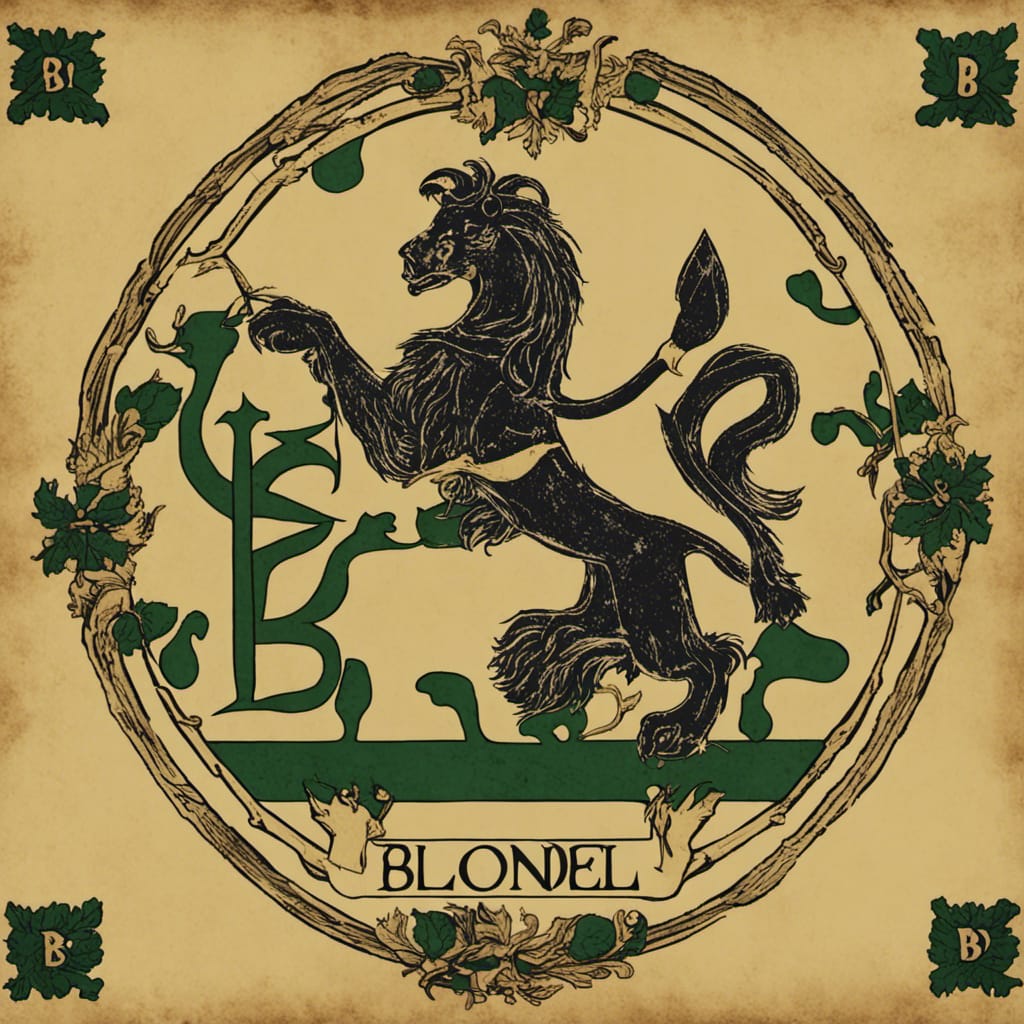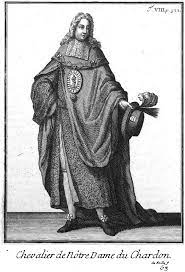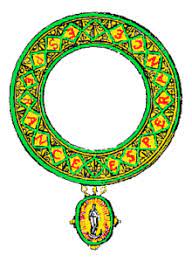


Knights of the Thistle of BourbonThe Lord Seignuer of the Fief Blondel maintains the Chevalier
Order of the Thistle of Bourbon which is probably
the 3rd oldest knighly order of chivalry of the Franks and
Normandy. By virtue of nobility and titles being outlawed in France and the fact that the Channel Islands are part of Normandy, the Seigneur has authorized the Order of the Thistle of Bourbon to operate on the lands and shores of the Fief Blondel in Guernsey where the Feudal Laws of the Fief s and the Bailiwick of Guernsey still apply. The Seigneur of Fief Blondel is a direct descendant of William the Conqueror, the Royal Capets, Charles de Valois 1270–1325 and the De Martels of France. The Seigneur of Fief Blondel has expanded the order to 120 Knights. The Seigneur's 16th great-grandfather is Louis IX Capet de Bourbon, King of France. The Seigneur of Fief Blondel today is the Chief Captain and Baron of Annaly-Longford, Lord Baron of Ennerdale Copeland and Lord of the Liberty of Stoborough.
Their Habit was a Mantle of Skie-coloured Damask, lined with red Satin, with broad Welts of Gold embroidered on the Collar. The Bonnet was of green Velvet, with a Tassel of Gold and crimson Silk hanging on the Band:
Their great Collar was of Gold, wrought and enameled with green; at the bottom where∣of, in an Oval, hung the figure of their Pa∣troness the blessed Virgin; as also the head of a Thistle enameled green and white. And these Knights were obliged daily to wear a Girdle or Belt of watchet Velvet embroidered with Gold, in the midst of which was wrought the wordEsperance.
Chancellor of the Order -Commissioner Dr. George Mentz, Seigneur of Blondel has been appointed by the Patriarch as the Chancellor of the Worldwide Anglican Church of Nigeria, Ghana, Kenya and Uganda which are larger than the United States. Lord Chancellor is the top legal official of the Worldwide Anglican Church which was also known as the Ancient Orthodox Church of Africa. Mentz has been devoted to Anglican charities for decades supporting scholarships for young aspiring adults worldwide. His Lordship George Mentz has also been consecrated as a missionary Bishop for the Anglican Church. Commissioner Mentz holds a Doctor of Jurisprudence and an MBA degree from nationally accredited law schools and business schools along with a DSS Doctor of Spiritual Studies from the Emerson Institute. Mentz has also served as a White House High Commissioner in the USA fo the Presidential Scholars Programs. The Knights of the Thistle of Bourbon, a chivalric order established by Louis II of Bourbon, in 1370, offers a range of noble and knightly titles. This order, primarily focused on the support of the House of Bourbon, conferred the following titles to its members:
The Knights of the Thistle of Bourbon, like many chivalric orders, had a strong connection to both martial and ceremonial roles, and the titles they conferred were often reflective of a person’s noble lineage, status, and service to the order. The titles were not just ceremonial but also carried significant prestige and power, depending on the holder’s social standing within the broader European nobility. The titles of Baron or Prince within the Knights of the Thistle of Bourbon were typically conferred by the Sovereign, Chancellor, or Grand Master of the order, who was often the Duke of Bourbon or a senior member of the Bourbon family. The authority to grant these titles was deeply tied to the order’s connection to the Ancient Feudal dynasty, and the titles were usually reserved for individuals of significant noble lineage or those who had performed extraordinary service to the Bourbon family or the order. Here’s how the process generally worked:
In both cases, the Chancellor or Grand Master acted as the central authority in granting these titles, and the conferral of such titles was often tied to both the individual’s noble status and their active participation in the order's missions or goals. As the order was closely connected to the Bourbon family, those granted high titles were often seen as loyal supporters of the family and the monarchy, reinforcing their status and political alliances.
Here are the key officers of the Order of the Thistle of Bourbon:
These officers worked in concert to manage the order’s day-to-day operations, ensuring that it maintained its prestige, performed its chivalric duties, and supported the Bourbon family’s influence in France and beyond. The specific roles and functions of these officers might have evolved over time, but the core leadership positions were tied to the order's noble and religious traditions. |
Seigneur de la Fief of Blondel Lord Baron Mentz of Fief Blondel Geurnsey Crown Dependency Seigneur Fief of Blondel George Mentz Lord Baron of Fiefdom Blondel Freiherr of Fief Thomas Blondel Feudal Lord of Baronnie - Noble Fief Barony Friherre > Order of the Thistle - of Bourbon Knightly Order of the Thistle Bourbon Knightood Knighted Seigneurs and Dames Travel Research Lord Paramount Feudal Barons The Seigneur Order Patron George Mentz Charter of Liberties Deed & Title Fief Blondel Islands Viking Kingdom Fief Worship Fiefs of the Islands ECS Extended Continental Shelf Styles and Dignities Territorial Waters Blondel Privy Seal Fief Bouvees of Fief Thomas Blondel Guernsey Court of Chief Pleas Fief Court Arms Motto Flower Fief de l'Eperon La Genouinne Kingdom of West Francia Fief DuQuemin Bouvée Phlipot Pain Bouvée Torquetil Bouvée Bourgeon Bailiwick of Ennerdale Channel Island History Fief Direct from the Crown A Funny Think Happened On the Way to the Fief Guernsey Bailiwick of Guernsey - Crown Dependency Confederation des Iles Anglo-Normandes Sovereignty Papal Bull Research Links Norse Normandy Order of the Genet Order of the Genet Order of the Star Est. 1022 Knights of theThistle of Bourbon Count of Anjou Fief Rights Blondel and King Richard Press Carnival Manorial Incidents Appointments of Seigneurs Store Portelet Beach Roquaine Bay Neustrasia Columbier Dovecote Fief Blondel Merchandise Fief Blondel Beaches Islands Foreshore Events Fiefs For Sale Sold Lords of Normandy Fief Coin Viscounts de Contentin Fief Blondel Map Feudal Guernsey Titles Board of Trustees The Feudal System Hereditaments Chancellor Flag & Arms Fief Videos Guernsey Castle Sark Contact Advowson Site Map Disclaimer Freiherr Livres de perchage Lord Baron Longford Income Tax Guernsey Valliscaulian Order Saint Benedict of the Celestines Society of Divine Compassion Dictionary Count of Mortain Seigneur de Saint-Sauveur Seigneur of Fief Ansquetil Top Success Books Datuk Seri George Mentz Order St. Benedict OSB Celestines Order of the Iron Crown Order of the White Falcon Colonel Mentz Order Red Eagle Order St. Louis Order Holy Ghost Order of Saint Anthony Order of the Black Swan Order of St Columban Order of the Iron Helmet Livonian Brothers of the Sword Fief treizième and Direct from Crown
Feudal Lord of the Fief Blondel of the Nordic Channel Islands Guernsey Est.
1179
Feudalherr - Fief Blondel von der Nordischen Insel Guernsey Est. 1179
New York Gazette - Magazine of Wall Street -
George Mentz -
George Mentz - Aspen Commission - Mentz Arms
Counselor George Mentz Esq. - Seigneur Feif BlondelBaron Annaly Baron Moyashel Grants to Delvin About Longford Styles and Dignities The Seigneur Court Barons Fiefs of the Islands Longford Map The Island Lords Market & Fair Fief Worship Channel Island History Fief Blondel Lord Baron Longford Fief Rights Fief Blondel Merchandise Events Blondel and King Richard Fief Coin Feudal Guernsey Titles The Feudal System Flag & Arms Castle Site Map Disclaimer Blondel Myth DictionaryMentz Scholarship Program 101 Million Donation - Order of the Genet Knighthood |





George Mentz Education -
Commissioner George Mentz
-
https://finance.yahoo.com/news/commissioner-george-mentz-clinches-influencer-180000705.html
-
George Mentz News -
George Mentz Net Worth - George Mentz Noble Tilte -
George Mentz -
George Mentz Trump Commissioner -
George Mentz Freiherren Count Baron -
George Mentz Global Economic Forum -
George Mentz Donates Millions

 This Order was instituted on New-years-day 1370. by
This Order was instituted on New-years-day 1370. by